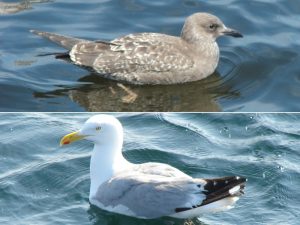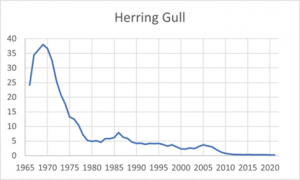(Photos and story by Pam Hunt)
The Herring Gull (Larus argentatus) is the quintessential “seagull” of the New England coast, but they have a long and convoluted history here. Early in the colonial period, their colonies were viewed as an easy source of eggs, and during this time the species was restricted to islands off the coast of Maine. The late 1800s saw increased exploitation for the millinery trade (the whole feathers as fashion trend) and further declines until official protection in the early 1900s. Being adaptable creatures, gulls then increased to the point of being pests, aided especially by the prevalence of open landfills, and spread south as a breeding species. Peak populations in New Hampshire probably occurred in the 1970s and 1980s, when birds were breeding on city rooftops and inland lakes. With fewer landfills available, the population is in slow decline, and probably closer to historic levels. The only reliable nesting in the state is now at the Isles of Shoals, although birds regularly wander inland along rivers during the non-breeding period.
Gulls are opportunistic foragers and are just as likely to eat berries or beg for French fries as they are to raid a tern colony or harass a merganser for its hard-caught fish. They are also problem solvers, as anyone who has watched one repeatedly drop clams on a parking lot knows. Multiple studies have demonstrated that gulls consider several factors when engaging in this behavior. If there are other gulls nearby they don’t fly as high before dropping their prey, since this increases the chance of a different gull stealing the food before the original gull can descend to retrieve it. At the same time, larger items typically need to be dropped from higher. The distance from where the prey is obtained to an appropriate solid surface may also factor into whatever calculations are going on in a gull’s head. So although they are often maligned, you’ve got to give gulls a lot of credit for making a place for themselves in a human-dominated landscape.

State of the Birds at a Glance:
- Habitat: Coastal, Lakes and Rivers, Developed
- Migration: Short distance
- Population trend: Strong decrease that has since flattened out at a low population size
- Threats: Human disturbance, prey declines, disease, pollution, contaminants
- Conservation actions: Reduce pollution, more data are needed on magnitude of threats
More information on “The State of New Hampshire’s Birds” is available here. Full species profiles in the format of “Bird of the Month” are now available here.

